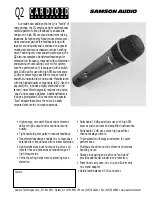
Please note that your SpectraPulse
®
system operates in a frequency band in a way which
may make its use subject to certain FCC and other regulatory agency restrictions and
licensing requirements. No changes or modifications may be made to this equipment
except by the expressly approved responsible party for compliance. Changes or
modifications could void the user’s authority to operate the equipment, and will also void
Audio-Technica warranty coverage. For further information, Please contact your local office
of the FCC as applicable.
Battery precautions
• Each mtu201 Wireless XLR Desk Stand is powered by 2 AA batteries; alkaline batteries
are included, but rechargeable SANYO brand NiMH AA batteries are recommended.
• Each cei007 Charging/Encryption Interface comes equipped with 14 rechargeable
SANYO brand NiMH AA batteries.
Note: Other models of NiMH batteries may work,
but the cei007, mtu101 and mtu201 are optimized for use with SANYO NiMH
AA batteries.
• SpectraPulse
®
cei007 Charging/Encryption Interface is intended only for use of mtu101
Boundary Microphone Transmitters and mtu201 XLR Desk Stand Transmitters equipped
with rechargeable AA Nickel Metal Hydride (NiMH) batteries. Do not use the charging
station for products other than the Audio-Technica SpectraPulse
®
system.
WARNING:
Do not use the cei007 Charging/Encryption Interface to charge batteries of other types
besides NiMH or damage may result.
• Rechargeable batteries must be charged before initial use or after prolonged non-use.
• When recharging, follow instructions in the
SpectraPulse
®
Owners Manual.
• When inserting batteries into the mtu201, observe correct polarity as marked.
• Do not use a leaking battery. If battery leakage occurs, avoid contact with skin. If contact
occurs, immediately wash thoroughly with soap and water. If battery leakage comes into
contact with your eyes, immediately flush with water and seek medical attention.
• Do not expose the batteries to fire. Do not heat, deform, solder, disassemble or modify.
• Do not peel off or damage the outer tube of a battery.
• Do not use these batteries together with dry cells, other types of batteries, new and
old batteries together, or batteries with different charge levels.
Note: This SpectraPulse
®
system is approved for indoor use only.
Note: See SpectraPulse
®
Owners Manual for full system specifications.
This device complies with Part 15 of the FCC rules.
Operation is subject to the following conditions:
(1) This device may not cause harmful interference and
(2) This device must accept any interference received, including interference which
may cause undesired operation.
Note: This equipment has been tested and found to comply with the limits for
a Class A digital device, pursuant to Part 15 of the FCC Rules. These limits are
designed to provide reasonable protection against harmful interference when the
equipment is operated in a commercial environment. This equipment generates,
uses, and can radiate radio frequency energy and, if not installed and used in
accordance with the instruction manual, may cause harmful interference to radio
communications. Operation of this equipment in a residential area is unlikely
to cause harmful interference. However, if the equipment does cause harmful
interference, the user will be required to correct the interference at own expense.
CAUTION!
Electrical shock can result from removal of SpectraPulse
®
components’ covers.
Refer servicing to qualified service personnel. No user-serviceable parts inside. Do not
expose to rain or moisture.
The circuits inside the SpectraPulse
®
components have been precisely adjusted for
optimum performance and compliance with federal regulations. Do not attempt to open
the drm141 Digital Receiver Module (main assembly), aci707 Audio Control Interface,
mtu101 Boundary Microphone Transmitter, mtu201 XLR Desk Stand Transmitter, or
cei007 Charging/Encryption Interface. To do so will void the warranty, and may cause
improper operation.
Notice to individuals with implanted cardiac pacemakers or AICD devices:
Any source of RF (radio frequency) energy may interfere with normal functioning of the
implanted device. All wireless microphones have low-power transmitters (less than 0.05
watts output) which are unlikely to cause difficulty, especially if they are at least a few
inches away.
Note also that any medical-device disruption will cease when the RF
transmitting source is turned off. Please contact your physician or medical-device
provider if you have any questions, or experience any problems with the use of
this or any other RF equipment.
2
3























